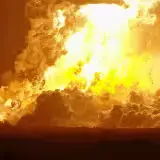SpaceX Test Rocket Explodes in Texas During Ground Trial; No Injuries Reported
A SpaceX prototype rocket undergoing ground testing at the company’s Texas facility exploded unexpectedly, sending smoke and debris into the air. No injuries were reported, and the incident is under investigation.
In a dramatic but controlled event, a SpaceX prototype rocket exploded during a ground test at the company’s Starbase facility in Boca Chica, Texas. The explosion occurred during an engine firing test and sent a plume of smoke and debris into the sky, prompting immediate attention from safety and engineering teams. Thankfully, no injuries were reported, and no significant damage was done to surrounding infrastructure.
The rocket, believed to be a development version of the Starship upper-stage or its Super Heavy booster, was undergoing static fire testing—an essential part of verifying engine performance and structural stability. According to company sources, the failure happened seconds into the test window, and automatic safety protocols were engaged as the test stand erupted in flames. ### What Happened at Starbase
Eyewitnesses near the Boca Chica site reported hearing a loud boom followed by thick black smoke rising from the test pad.
Videos posted to social media showed a rapid succession of flashes before the explosion. Within minutes, SpaceX teams were seen assessing the site as fire suppression systems activated automatically. SpaceX has not yet confirmed which exact prototype was involved, though analysts believe it was a non-flight-ready version intended purely for ground testing.
The company frequently tests and iterates rapidly, with many prototypes built specifically to probe the limits of their design under real-world conditions. “This kind of test failure is part of the learning process,” said aerospace analyst Jennifer Kwong. “It’s costly and spectacular, but not entirely unexpected in the development of next-generation launch vehicles.
”
### Rapid Iteration is Key to SpaceX Strategy
Unlike traditional aerospace companies, SpaceX uses a development philosophy known as “test, fail, fix, fly. ” Rather than rely solely on simulation, the company builds physical prototypes, tests them to failure, and incorporates lessons directly into new designs. It’s a model that’s helped them achieve several key milestones faster than expected.
“SpaceX embraces rapid prototyping,” said former NASA engineer Mark Jefferson. “That sometimes means dramatic failures. But it also accelerates innovation in a way government programs often cannot.
”
Indeed, SpaceX has already conducted dozens of test flights, static fires, and launch attempts with the Starship and Super Heavy booster systems. Several earlier prototypes have been lost during testing—often on purpose—as engineers collect data on stress limits, propulsion dynamics, and structural tolerances. ### The Bigger Picture: What This Means for Starship
Starship is SpaceX’s fully reusable, next-generation spacecraft, designed to carry both humans and cargo to destinations like the Moon, Mars, and beyond.
It is the centerpiece of Elon Musk’s long-term vision for interplanetary travel. Standing nearly 400 feet tall when combined with its Super Heavy booster, Starship is the tallest and most powerful rocket ever built. The test that ended in an explosion was part of a routine development phase leading up to upcoming orbital launch attempts.
Though dramatic, this latest incident is unlikely to derail the program significantly. “Failures like this are baked into the schedule,” noted space policy expert Dr. Anjali Suresh.
“SpaceX factors them in and keeps building. It’s part of how they’ve managed to move so quickly on Starship. ”
The company’s goal is to develop a fully reusable spacecraft capable of ferrying 100+ metric tons into low Earth orbit.
NASA has already selected a variant of Starship to serve as the lunar lander for its Artemis program, targeting a return to the Moon in the late 2020s. ### Safety First: No Injuries or Environmental Threats
In the wake of the explosion, SpaceX confirmed that no personnel were injured. The test area was properly secured, and safety protocols functioned as designed.
Local authorities and environmental monitors were alerted but reported no contamination or hazards to the surrounding area. The company emphasized that the explosion occurred in a designated hazard zone. “These test stands are built with worst-case scenarios in mind,” Jefferson added.
“It’s loud, messy, and expensive—but it’s also a controlled failure. ”
Boca Chica residents, used to the occasional test fire and loud booms, took the incident in stride. Several commented on the scale of the explosion, with one local joking on social media, “There goes another one — but that’s just life with Elon as a neighbor.
”
### What Happens Next
SpaceX engineers are already combing through telemetry and sensor data to determine the exact cause of the failure. The company typically completes post-test analyses within days and uses those insights to make immediate modifications to the next prototype. Musk himself has often pointed out that success in aerospace is paved with explosions.
In 2021, a series of Starship prototypes exploded during landing tests before SN15 finally succeeded. Each failure, Musk said, was “just data in disguise. ”
Once the root cause is identified, engineers will decide whether a hardware fix, software update, or design adjustment is needed.
A new prototype will be prepared for the next round of testing—sometimes within weeks. ### Industry Response and Investor Impact
The explosion, while visually alarming, had minimal impact on investor confidence. SpaceX remains a private company with significant funding from private equity, NASA contracts, and Starlink revenue.
Analysts say the market has grown accustomed to SpaceX’s explosive—but ultimately productive—testing style. “The fact that no one was hurt and data was collected actually reassures investors,” said aerospace venture capitalist Tyler Brant. “It proves that the company is pushing the envelope safely.
”
NASA has also expressed continued confidence in SpaceX, praising the company’s pace and commitment to safety. “SpaceX has shown again and again that it learns quickly,” said a NASA spokesperson. “We are confident in their ability to deliver on Starship.
”
### A Reminder of the Risks in Spaceflight
While the incident was contained and did not involve any flight hardware or payloads, it serves as a reminder that spaceflight—especially at the cutting edge—remains a risky and unforgiving domain. Public interest in SpaceX has grown steadily with each Starship milestone, and moments like these highlight the volatility of pioneering new technology. They also underscore how much work remains to reach goals like lunar landings or Mars colonization.
Yet, history shows that every major leap in aerospace—from the Apollo program to Space Shuttle to Falcon 9—has been paved with setbacks. “In aerospace, failure is just the tuition you pay for progress,” Suresh said. ### Conclusion
The explosion of a SpaceX test rocket in Texas may have rattled windows and drawn headlines, but it is far from a disaster.
It represents one more step in the complex, iterative process of building the world’s most powerful rocket system. With no injuries, rapid data recovery, and unwavering commitment to improvement, SpaceX will continue its march toward spaceflight history—one test at a time, one prototype at a time, and yes, sometimes, one explosion at a time. As Elon Musk once tweeted during an earlier Starship test: “Mars, here we come.
Just as soon as we figure out how not to explode on the way. ”.




